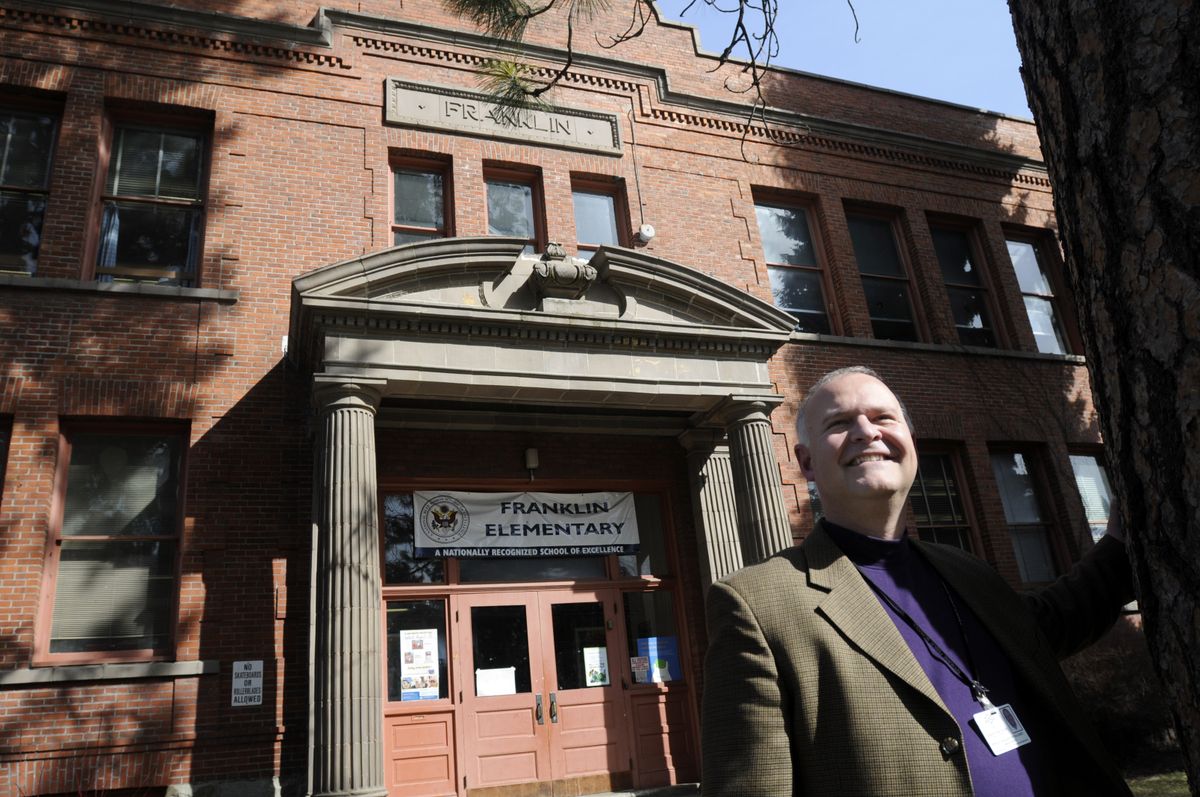Celebrating a century of Franklin
South Side elementary school plans parade, festival to mark 100 years

The faces of the children in the black-and-white photo, more than 60 years old, look just like the faces of children today.
In June 1946, Ray Strecker, Mary Masters and Byron Johnson lined up neatly outside Franklin Elementary School to have their kindergarten picture taken. Miss Gladys Hoagland watched over her 37 students as they squinted at the camera in the exact place where hundreds of other students have had their picture taken.
Franklin Elementary is turning 100 and will be celebrated with a parade, lunch and festival May 22. Brian Shute, the speech language pathologist at Franklin, has been digging in crates and corners, finding old newspaper clips, class photos and letters from alumni as he set out to document the school’s history.
“I guess I’ve been at it for about two years, and there was a lot of stuff already here,” Shute said. “And I kept finding more pictures and other interesting things at the school.”
Shute said that the first Franklin School was built in 1889 on Front Street, now Trent Avenue.
“Then the railroad wanted the building, because they wanted the land,” Shute said.
Old newspaper articles show that the railroad got the property through condemnation, but was taken to court. In 1909, the railroad paid $115,000 to the school board – quite a sum for a building valued at $10,000 about 10 years earlier.
“And then it burned down after the railroad got it; it was some scandal,” said Shute. “It was a brick building, so it was mostly gutted by the fire – and then it was torn down.”
In 1909 Franklin Elementary on 17th Avenue was completed. It was designed by architect Loren Rand, who also designed the oldest part of Lewis and Clark High School.
“It used to run from first through eighth grade,” Shute said.
A longstanding rumor among Franklin students is that the school was built as a jail, but Shute said that’s not true.
“It was always a school,” he said, laughing. “It was never, ever a jail. There are some strange windows downstairs by the bathrooms, and maybe that’s where the idea comes from.”
In the 1950s, parents raised money to add a kindergarten to the school. It was essentially a private home converted for kindergarteners.
The new wing, which includes a gym and classrooms along 17th Avenue, was dedicated in 1953.
Out of 100 years of graduates came many doctors, lawyers and politicians, Shute said. Former Idaho Gov. Dirk Kempthorn went to Franklin, as did Spokesman-Review columnist Doug Clark.
“The school has always been an integrated part of the neighborhood,” Shute said. “The South Hill looked a lot different when it was built, when materials made it here by horse and wagon, than it does today – but this has always been a thriving area.”
Over the years alumni have submitted old photos, letters, cards and programs from school plays and other events.
“Alumni have been providing lots of oral history and pictures,” said Shute as he carefully turned the pages of a school scrapbook. “But we have holes in the history, especially in the 1980s and 1990s.”
Shute hopes Franklin alumni and parents will go through basement boxes and old folders looking for mementos to share with the school.
“The hillside out here, between the upper and lower playgrounds, is clay, and they used to take clay from there and make little ‘pinch pots’ they’d have fired,” he said. “It would be fun to have one of those.”
One photo in the scrapbook is of The Lucky Five Club, a club with far more than five boys, Shute said.
“They were a group that went hiking and exploring on the South Hill and beyond,” he said, pointing to the group of tow-haired boys picnicking in the picture.
Other photos show spring frolics and patriotic pageants, baseball and basketball teams – most of the pictures taken right there in front of the impressive columns that still guard the front door. So what does it mean to students today that their school is 100 years old?
“Well, they get a kick out of seeing some of the same places as in the old photos,” Shute said. “And when they meet older alumni, someone who’s maybe 80, and realize they were a kid, too, in one of the pictures – that’s just so great.”